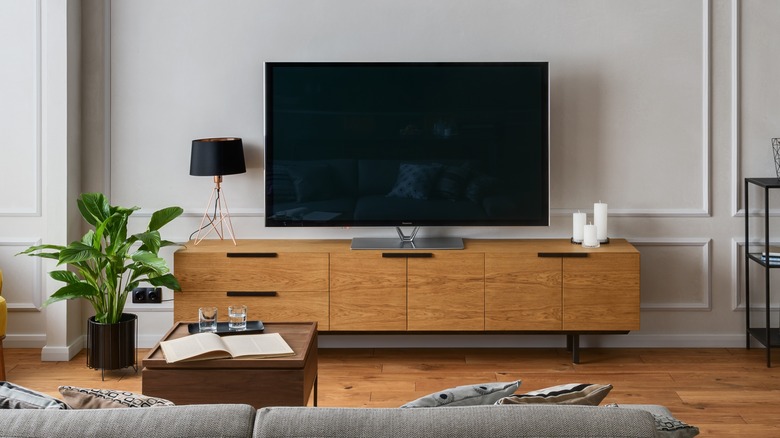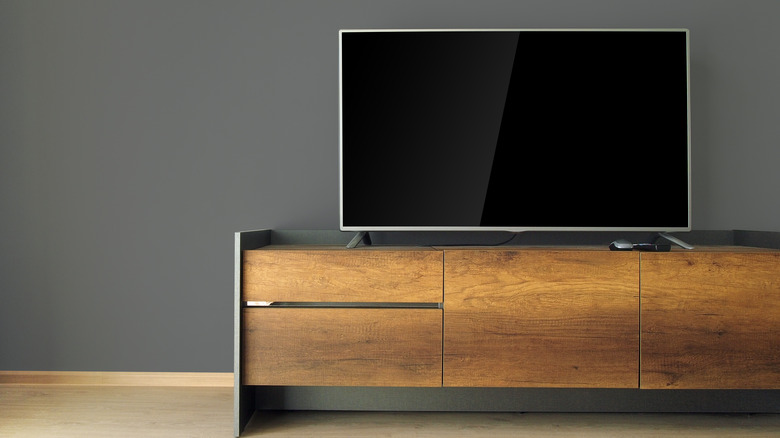TV Stand Size Guide: What Size Console Do You Need?
Even if the days of cable are gradually becoming a thing of the past, the television itself remains a popular household appliance. These devices have gained sleek designs, bolder displays, and innovative smart features, evolving with the times and remaining a consistent mainstay of living rooms across the world for gaming, streaming, and more. However, getting a TV is only the first step, as you'll also want to find a stand or console best goes with it.
Of all the factors to consider when looking for a TV stand such as the style or where to place it in the room, perhaps none is more important than its size. Just as there are major mistakes you can make when buying a new TV, underestimating this element can have negative repercussions down the line. You may get a stand that's way larger than your TV and eats up unnecessary space or — even worse — your stand is far too small and has trouble supporting the size and weight of your television.
But even if you are conscious of the importance that size plays when picking out a TV stand, it's easy to be misled regarding how to measure your TV and the stand that works best with it. To help you better determine your ideal TV stand size, we've put together a simple guide on how to go about deciphering the many variables involved.
How TVs are measured
It's important to get down the measurements of your television before getting a stand that will fit it. However, trusting the dimensions that your TV was advertised as isn't as accurate as you might think. In reality, the advertised measurements of your TV are only taking into account the diagonal measurement of the screen, meaning from the top left corner to the bottom right corner of the screen rather than the full width of the TV itself.
Because of this, the size information your TV came with is not going to serve you all that well. It'll be up to you to get the accurate measurements of your TV. Simply do this by measuring the complete width of the TV from one end of the frame to the other end with measuring tape. Additionally, you can call the manufacturer to receive these dimensions if you don't have a measuring tool at hand.
The height of your TV is another factor that's easy to neglect. You want everyone watching the TV to be able to comfortably view it rather than tilting their heads in an uncomfortable fashion, which can occur if you get a stand that's too tall or short. To determine this, you'll want to measure the distance from the floor to the eye level of wherever you'll be watching it from. Subtract the height of your TV from this number and find a stand that best lines up with that difference.
How to find a stand that your TV fits on
Once you have the total width of your television down, it will be much easier to determine the size of stand to get. As stated before, a stand that's too small poses the risk of having your TV tip over due to poor support while one that's too long will take up a lot of room and looking unappealing. So it's important to familiarize yourself with the most common TV stand measurements.
In general, there are three kinds of TV stand sizes to consider. A compact TV stand is typically somewhere between 42 and 60 inches in length, making them ideal for bedrooms or small spaces. Medium-sized TV stands are usually between 55 and 70 inches and are used in living rooms or spacious bedrooms, often coming with extra storage options. Finally, there are large TV stands that measure 70 inches or more. As you imagine, these are for the largest TV types and can be found in a wide array of rich designs and with additional decor elements.
To achieve the best balance, you'll want your stand to be a bit wider than the TV itself. Shoot for having there be three inches of space from the edge of the stand for the most uniform result. However, some may prefer going a bit longer with the intent of adding decorations or photos besides their TV. At the end of the day, it's all about making the best use of your space while making sure your TV is secure.


